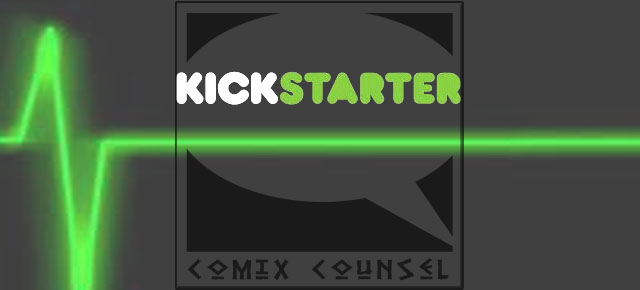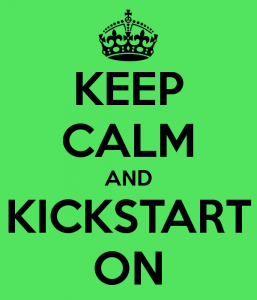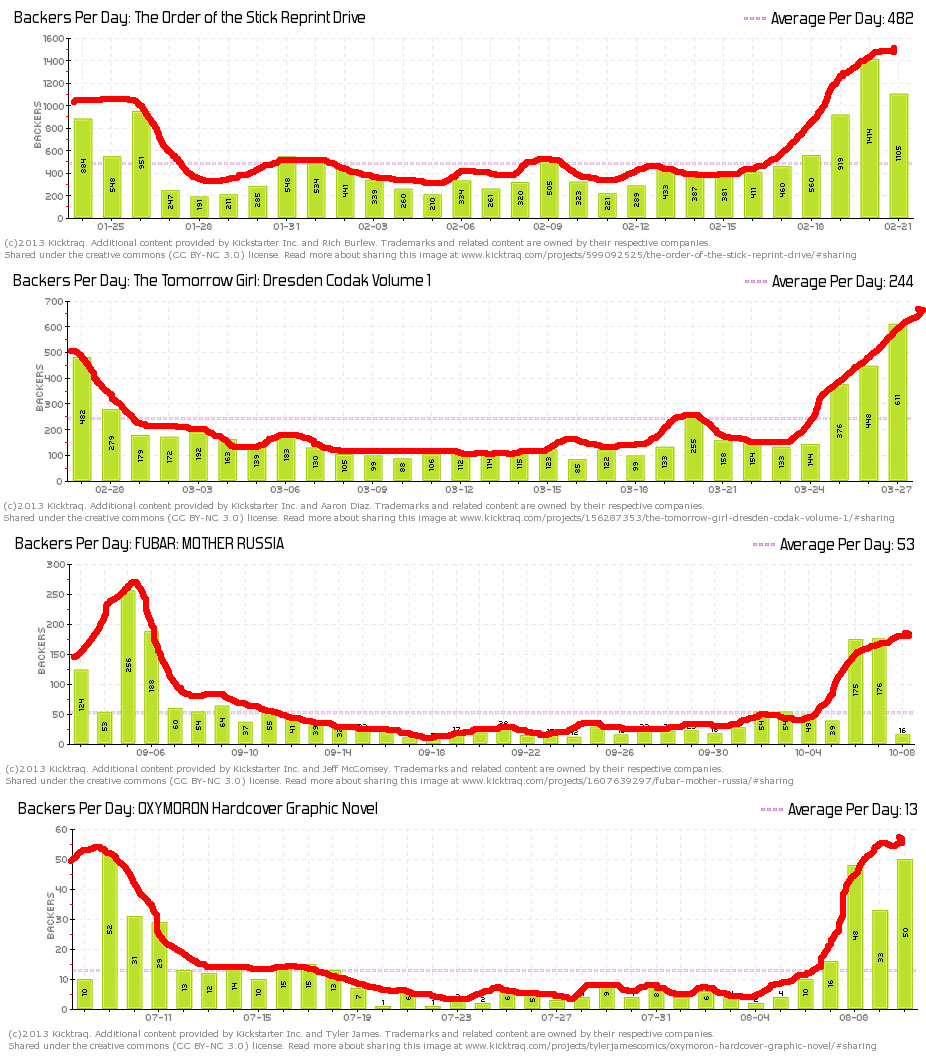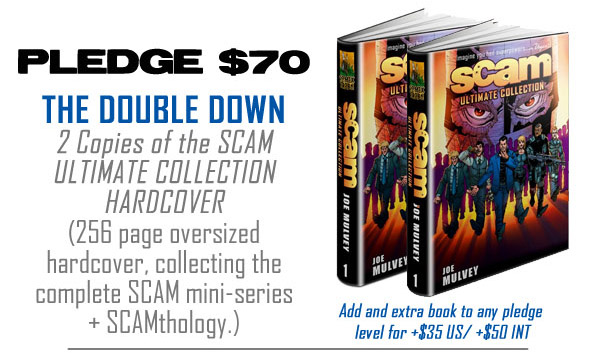Kickstalling: 9 Things to Do During the “Dead Zone” of a Kickstarter Campaign

You did it, you launched a Kickstarter campaign!
After months of planning, crunching numbers, and reading every article you can about Kickstarter (especially of the great ones here at ComixTribe), you finally pulled the trigger on your campaign. And, much to your delight, you came out of the gate hot! You had a great first day, maybe even better than you had hoped. Your core fans and supporters came out in droves, and a whole bunch of names you didn’t recognize found you on the Kickstarter platform and backed you, too. Your smartphone was buzzing like a bee all day and night as pledge after pledge came in a steady stream. Awesome!
Fast forward a week or two, and maybe you’re not feeling quite so awesome.
Where in the first few days of the campaign pledges were coming in fast and furious, by week two you find they are now few and far between. Where you were once thinking, “Oh my God, what am I going to do for stretch goals?” now you might be thinking, “Oh my God, what if I don’t hit goal?” Where you had nothing but a smile on your face when backers were coming in one after another, now you’re stressing as some backers lower, or even cancel their pledges. This campaign started out so promising…where did you go wrong?
Relax. Take a deep breath.
This is the part about running a Kickstarter campaign that most people don’t talk about. Compared to planning and fulfillment, the actual campaign is often the shortest phase of a Kickstarter project, and perhaps that’s why it gets less coverage than the other topics. This past month, I’ve been advising writer/artist Joe Mulvey, who is currently in the last week of an ambitious Kickstarter campaign to raise $25,000 for the SCAM Ultimate Collection. Joe has experienced this phenomenon, running this, his first campaign. While the emotional highs and lows were completely new to Joe, all of this is pretty much standard operating procedure for a Kickstarter project.
What follows are nine recommendations for what to do when it appears your Kickstarter project is “Kickstalling.”
1. Don’t Panic!
It’s not you, and it’s not your project. It’s the laws of rational human behavior, and campaign funding mechanics that lead to the Kickstarter “Dead Zone.” And virtually all projects, big and small, are susceptible to it. Take a look:
The above chart shows the number of backers per day for four successful Kickstarter comic book projects of varying sizes, as taken from Kicktraq.com. Included are the two biggest all-time comics Kickstarter projects, The Order of the Stick ($1,254,120), The Tomorrow Girl ($534,994), last year’s most funded comic book project Fubar: Mother Russia ($95,908), and ComixTribe’s biggest Kickstarter project to date, Oxymoron Vol. 1 ($26,000). While the scale and total number of backers on each of these projects certainly varied, the general shape of the curves for each campaign is roughly the same.
The shape of a Kickstarter campaign is that of two steep hills at the beginning and the end, with a long, flat valley (aka the “Dead Zone”) in the middle.
If even the biggest and best Kickstarters suffer from this phenomenon, you can and should expect yours will, too. So, the question isn’t “How do I avoid the dead zone?”, but rather, “What can I do to mitigate its effect, and keep pushing through it, so that I get my second steep hill on the other end, and that late surge is enough to get me to goal?”
2. Show Gratitude
Now, this is something that sounds like a piece of obvious advice, until you actually start running a Kickstarter campaign. In the early days of a campaign, backers can pop up so frequently, that even sending them a quick message to say “Hey, thanks for backing!” is very tough to keep up with. If you were running the campaign as a full time job, it might be manageable, but I dare say most Kickstarters have other obligations competing for their time while the campaign is running.
 However, the “Dead Zone” is a great time to get caught up on sending personalized thank you’s to all your backers.
However, the “Dead Zone” is a great time to get caught up on sending personalized thank you’s to all your backers.
Campaigns are funny. With all the metrics and meters, it’s very easy to reduce a Kickstarter to numbers and dollar amounts, and to see “backers” as this singular entity there for sole purpose of making your dream come true. And of course, that’s all complete bullshit.
Behind every dollar is an actual human being who was gracious enough to not only part with their most valuable resource (their time) and listen to your pitch, but also to kick in a pledge of real money to help you make your project happen. And this is while there are thousands of other worthy projects on Kickstarter and millions of other products in the world also vying for their time and attention. The fact that someone is backing your project is actually pretty extraordinary when you think about it.
And that deserves a short, personalized acknowledgement. And while I have no study data to prove the point, it seems logical that backers who have been personally thanked by a project creator are probably A) More likely to be receptive to upping their bid for higher level pledges and B) Less likely to pull their support from the project and cancel their bid. So, if you needed a self-interested reason to say thank you, besides it being the proper thing your momma taught you to do, there’s one for you.
3. Use Your Public Updates Wisely
Kickstarter’s internal updates system is probably the most powerful tool you have to keep momentum going through the dead zone. Current backers can be your campaign’s most powerful force, and campaign updates are the best way to rally them.
When you run a Kickstarter campaign, you have the ability to post an update to your project page, which can be seen by anyone. Updates will also be emailed directly to all current backers. (You can also send Backers-Only Updates if you only want backers to see a certain message…I’ll discuss those later.)
A good public update:
- Is short and sweet, and skim-able – I back a lot of Kickstarter projects, and as such, I get a lot of Kickstarter updates sent to my inbox. I probably spend about 10-20 seconds “reading” each of them, and since I’m not a speed reader, that means I’m not reading all that much at all. Skimming is probably a better word for it…what’s new, interesting, or relevant to me, and I’m gone. And I’m pretty sure most backers treat updates the same way. You are not special, so don’t waste a ton of effort writing long missives that no one will read.
- Contains a nice balance of text and images – Blog posts with images get read 60% more often than those without. I expect it’s even greater for Kickstarter updates, and especially for projects in a visual medium like graphic novels. I’d go so far as to recommend not sending out an update unless you have a good image to go with it. We just established that most backers are going to skim, not read your update, so give them an image to go with your messaging to make it stick. Infographics can be especially powerful as well.
- May include a short videos as well. If you have the ability to make decent videos quickly, a short (2 minutes or less) video can be even more effective than a text and image post.
- Is targeted at current backers, but welcoming to new ones. Remember, most of the people who will be reading and seeing your update are already committed to your project. So, don’t waste time repeating the material on your project page in updates. Instead, share new information, stories, art, anecdotes, or campaign developments in updates. (More on this to come.)
- Occasional calls to action – You want to be respectful of people’s time, and recognize that your backers have already done an amazing thing by pledging to your campaign. That said, occasionally asking, and more importantly making it INCREDIBLY EASY for backers to help promote the campaign further is a good use of your updates. My favorite tool for this is Click to Tweet. Here’s an example:
“Last chance to get in on Joe Mulvey’s SCAM! Great Kickstarter ends this week.” (Click to Tweet)
Click to Tweet gives backers a message to spread that only requires a couple mouse clicks, making it a reasonable ask for backers.
- Is Consistent, Expected, and Ideally Enthusiastically Anticipated – One brilliant thing Joe has done with his campaign is use his biggest asset, the fact that he is an outstanding and fast illustrator, to his advantage by posting and selling daily warm-up sketches as pledge add-ons. In this update, Joe candidly explained that he would be posting daily sketches and making them available on a first comment, first get basis. He has proceeded to post one each day. He’s also taken suggestions from backers for what to draw, adding an interactive component to the campaign, as well as increasing the likelihood that the sketches he draws will be claimed. A daily sketch from Joe became an added incentive for backing SCAM.
4. Add New Pledge Levels
One of the most successful strategies for keeping momentum going throughout the campaign is to add new pledge levels. While you certainly want to launch with a nice set of core pledge levels at a range of price points, I recommend saving some pledge levels to announce during the campaign.
New pledge levels could be incredibly creative and one-of-a-kind, like this opportunity to get killed by a ghost in Joe’s next book:
Or simply a reaction to backer queries on how much adding another book to their pledge would be:
The best reason to post additional rewards throughout the campaign is that it gives you new reasons to talk about your campaign. And whenever you add a new pledge, be sure to:
- Let your backers know about it in an update.
- Visualize that new reward with an image.
5. Celebrate Milestones
For Joe, raising $25,000 for a comic book Kickstarter was never going to be an easy task. While it may seem like there’s a wildly successful new Kickstarter project every month, it’s important to keep in mind that only 6% of the comic book projects launched on Kickstarter have raised more than $20K. This is why it’s so important to make sure your project’s goal is aligned with your current audience, ability to get the word out, and your product’s appeal.
To get to ambitious funding goals, a great strategy is to break up that funding goal into a series of milestones, and then “celebrate” those milestones.
Milestones you might celebrate:
- Funding Totals – People love nice round numbers, so celebrating hitting $1K, $5K, $10K, or $50K, along the way to your goal can be a good strategy.
- Funding Percentages – Likewise, percentages of funding is something the public easily grasps. 25%, 50%, 75% or whatever breakdowns make sense to you.
- Backer Totals – Another thing to celebrate is total number of backers. After a week into the campaign, it’s pretty easy to estimate how many backers you’ll need to hit your goal. Simply divide your goal by the average pledge level of current backers. You might then choose to celebrate round numbers of backers on the way to that target backer total.
Of course, you can always get creative. Kickstarter gives you a lot of tools. If he wanted to, Joe could celebrate every time a backer also named Joe joins the campaign, or unlock a special reward should a certain number of backers come over from a particular website or promotion.
How should you celebrate milestones:
- Unlock backers-only rewards – For example, in the SCAM campaign, Joe has already made two bonus digital comics, two sketchbooks, free SCAM wallpaper, and several new comic previews available as backers-only rewards. Whether the campaign hits its funding goal or not, SCAM backers have already received a bunch of cool stuff, ideally making backing worth their time. Ideally, this also encourages on-the-fence backers to get in on the campaign, rather than sit idly by.
- Reveal new pledges – I already talked about the power of adding new pledges to the campaign. Linking the unveiling of those pledges to campaign milestones is a great way to celebrate them.
- Unveil more of the project – You always want to take advantage of the unique strengths of your project when running a campaign. In Joe’s case, the amount of great art is a real strength for SCAM. He tied the reveal of this awesome Richard Clark pin-up that will be featured in the book to backers joining the campaign, revealing a puzzle piece for each backer. A cool technique.
6. Stop Checking Kicktraq!
Look, Kicktraq.com is a great tool for studying past campaigns, as I’ve used it above.
 But obsessing over it as a projection tool for how YOUR campaign is going to actually do will likely do more harm than good. Early on in the campaign, it will show you insane projections for how much money your project is trending toward. (Ignore those completely.) Likewise, do not freak out if, while in the Dead Zone, it starts to show your project as trending toward not making your goal.
But obsessing over it as a projection tool for how YOUR campaign is going to actually do will likely do more harm than good. Early on in the campaign, it will show you insane projections for how much money your project is trending toward. (Ignore those completely.) Likewise, do not freak out if, while in the Dead Zone, it starts to show your project as trending toward not making your goal.
Time spent analyzing projections and stressing about where your campaign might be headed is time not spent on improving your campaign right now.
7. Tell stories.
I liken a Kickstarter campaign to a month-long online convention. It’s a chance for creators to reconnect with longtime friends, fans, and supporters, as well as pick up new ones. Sure, the campaign is around one solid tangible goal (the product), but when done right, it’s also a chance for you the creator to connect with backers and show your passion for your project. Backers are not simply supporting the PRODUCT…they’re also supporting YOU, the creator.
So, keep use your updates to tell stories. Here’s one that I chimed in on Joe’s behalf:
Like comic conventions, a well-run Kickstarter campaign is a great opportunity to win over new fans for life. Take advantage of the limited time and attention you have with backers to entertain them even before you put a product in their hands.
8. Keep Pitching Your Project to Media
Jimmy Palmiotti launched his sixth Kickstarter campaign two weeks ago, and within a few days, his project had been covered by all the top comic book sites as well as USA Today. It’s no wonder it was funded in less than a week. As a “Kickstarter veteran”, Jimmy sets up his media interviews well in advance of the campaign launch date, and you should, too.
But, just because your campaign has already started doesn’t mean you shouldn’t still be trying to get it covered by the relevant news sites in your field. Mulvey has been very active in this regard, appearing on Podcasts, soliciting interviews, and writing original articles that tie into his project for major sites.
This isn’t Kevin Costner’s field of dreams here…the clock is going to run out on your campaign if you wait for media to come to you. So be proactive.
9. Don’t be desperate.
Passion sells. Desperation kills.
There are going to be ups and downs in a Kickstarter campaign, just like there are ups and downs in a career. The absolute worse thing you can do is act desperate and start flailing when your project starts “Kickstalling.”
 What does acting desperate look like? Here are a few signs:
What does acting desperate look like? Here are a few signs:
- Making major changes to the fundamentals of your campaign, like slashing prices on reward levels or contradicting earlier pronouncements. This sort of “flailing” will make current and potential backers question whether or not you really did do your homework.
- Barking up the wrong trees, or starting to SPAM any and every celebrity or “name” in your genre and asking for them to share or back your project. If you have no prior relationship with that person, that’s just rude.
- Check your language. There have been some interesting studies to come out recently, about the language used in successful and unsuccessful Kickstarter campaigns. While this research hasn’t produced a clear cut “Say this/Don’t say that” guide, my take away from it is that successful projects consistently write in a tone that the project’s success is inevitable, while unsuccessful projects often sound as if the project’s funding is in doubt.
An unsuccessful Kickstarter campaign is not the end of the world. As we’ve chronicled here, it’s quite possible to rebound from an unsuccessful Kickstarter incredibly fast. But how you behave, in success and in failure, is something that will have a long shelf-life. Don’t let a case of the Kickstarter-crazies tarnish your reputation.
Be steady, hold the fort, and stick to the plan.
***
I hope these tips help you productively push through your Kickstarter “Dead Zone” and I want to thank Joe Mulvey for letting me use SCAM Ultimate Collection Kickstarter for examples. Joe has really run an outstanding campaign, using short, art-infused daily updates to keep momentum going throughout the campaign.
With a few thousand dollars left to go to hit goal, I know Joe is going to be on pins and needles all week. So if you found this article helpful at all, I encourage you to check out the SCAM Ultimate Collection Campaign and consider backing it.
What’d I Miss?
Do you have any additional tips for things to do when it seems your project is Kickstalling? What’s worked to push you through the Dead Zone of a campaign?
Feel free to share your ideas in the ComixTribe forums at Digital Webbing.
Have you found this article helpful? Consider sharing it:
“Must read – 9 Things to Do During the “Dead Zone” of a #Kickstarter Campaign” (Click to Tweet)
Keep Reading!
If you found this article useful, you may want to read one of these three articles next:
How NOT to Get Stretched by Kickstarter Stretch Goals
DIY Crowdfunding Fulfillment Part I – What To Do BEFORE You Launch?
DIY Crowdfunding Fulfillment Part II – Ship Like a Boss
Related Posts:
Category: Comix Counsel






















Comments (1)
Trackback URL | Comments RSS Feed
Sites That Link to this Post